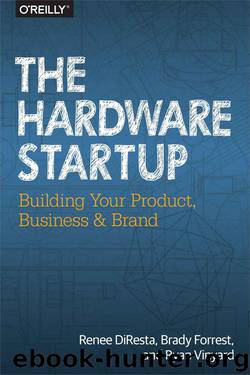The Hardware Startup - Building Your Product, Business, and Brand by Renee DiResta Brady Forrest & Ryan Vinyard

Author:Renee DiResta, Brady Forrest & Ryan Vinyard [Renee DiResta, Brady Forrest & Vinyard, Ryan]
Language: eng
Format: epub
Tags: gnv64
Publisher: O'Reilly Media, Inc.
Published: 2015-06-14T18:30:00+00:00
Figure 8-1. Misfit’s Indiegogo campaign timeline (courtesy of Sonny Vu)
Figure 8-2. A detailed schedule of the launch day circled in Figure 8-1
* * *
< Bmheight="15 ap height="8" align="left">Pricing your perks appropriately affects not only your crowdfunding campaign success; it is important to the success of your overall business as well. Chapter 10 discusses product pricing in more detail. If you’re opting to do a crowdfunding campaign as your public unveiling, read that section. Many hardware founders who launch on a crowdfunding platform significantly underprice their products. They don’t factor in the margin required to be profitable on the other distribution channels that they’ll be selling on after the campaign. The public is introduced to the product at a low price point…and then sees it costing 25–50 percent more in stores or on the company website a few months later. This might make early backers feel like they’ve gotten a great deal, but it creates the impression that you’ve raised prices. It’s great to reward your crowdfunding supporters for taking a chance and buying something that doesn’t exist yet, but pursue this strategy deliberately. Be sure you know what your postcrowdfunding price will be before you start your campaign.
Inexpensive schwag isn’t the only option for adding more perks to your campaign. Consider adding special treats to the high end as well. High-tier rewards that incorporate backers directly into your process can be appealing to crowdfunders who want to be involved in the development. A backer can help name a product line or be added to a beta-tester list for early runs. You can also offer experiences, such as an in-person or Skype demo, a workshop on how to use the product, or a personalized tour of your office or lab. Just be sure to properly calculate the cost of these types of rewards…including your time!
Some hardware companies offer their product as either a kit (low-price tier) or a fully assembled version (high-price tier). Consider offering limited-edition versions or colors of your core product, or campaign-only accessories; scarcity is a very powerful motivator. Some campaigns offer stretch goals: things that the team will do if they reach a certain total dollar amount.
Otherfab, makers of the Othermill (a desktop CNC mill) ran a Kickstarter campaign asking for $50,000 but also mentioning several stretch goals. If the campaign reached $100,000, the company would create a job for a machinist. At $250,000 it would expand its software offering ahead of schedule. At $500,000 it would be able to create a second production line, so it could ship all of the mills much more quickly. The project raised $311,657.
While creativity might tempt you to offer a ton of different rewards, don’t overdo it. The average for a successful project on Kickstarter is nine. If you’re on a platform with a flexible perk structure and something isn’t selling well, you can adjust perk pricing or offerings while the raise is ongoing. This enables the founder to experiment with different feature sets and price points, and to use the crowdfunding process for deep market exploration.
Download
This site does not store any files on its server. We only index and link to content provided by other sites. Please contact the content providers to delete copyright contents if any and email us, we'll remove relevant links or contents immediately.
Whiskies Galore by Ian Buxton(40277)
Introduction to Aircraft Design (Cambridge Aerospace Series) by John P. Fielding(32327)
Small Unmanned Fixed-wing Aircraft Design by Andrew J. Keane Andras Sobester James P. Scanlan & András Sóbester & James P. Scanlan(32134)
Craft Beer for the Homebrewer by Michael Agnew(17437)
Turbulence by E. J. Noyes(7031)
The Complete Stick Figure Physics Tutorials by Allen Sarah(6627)
Kaplan MCAT General Chemistry Review by Kaplan(6043)
The Thirst by Nesbo Jo(5775)
Bad Blood by John Carreyrou(5759)
Learning SQL by Alan Beaulieu(5396)
Weapons of Math Destruction by Cathy O'Neil(5026)
Man-made Catastrophes and Risk Information Concealment by Dmitry Chernov & Didier Sornette(4723)
iGen by Jean M. Twenge(4692)
Digital Minimalism by Cal Newport;(4501)
Life 3.0: Being Human in the Age of Artificial Intelligence by Tegmark Max(4490)
Audition by Ryu Murakami(4089)
1,001 ASVAB Practice Questions For Dummies by Powers Rod(4033)
Electronic Devices & Circuits by Jacob Millman & Christos C. Halkias(4014)
Pale Blue Dot by Carl Sagan(3992)
